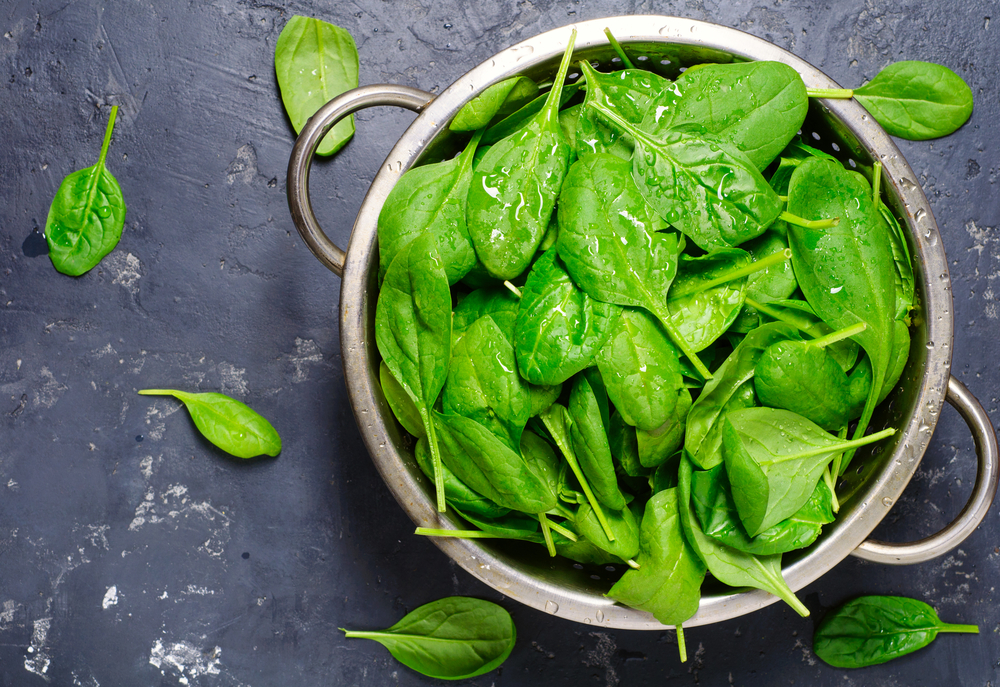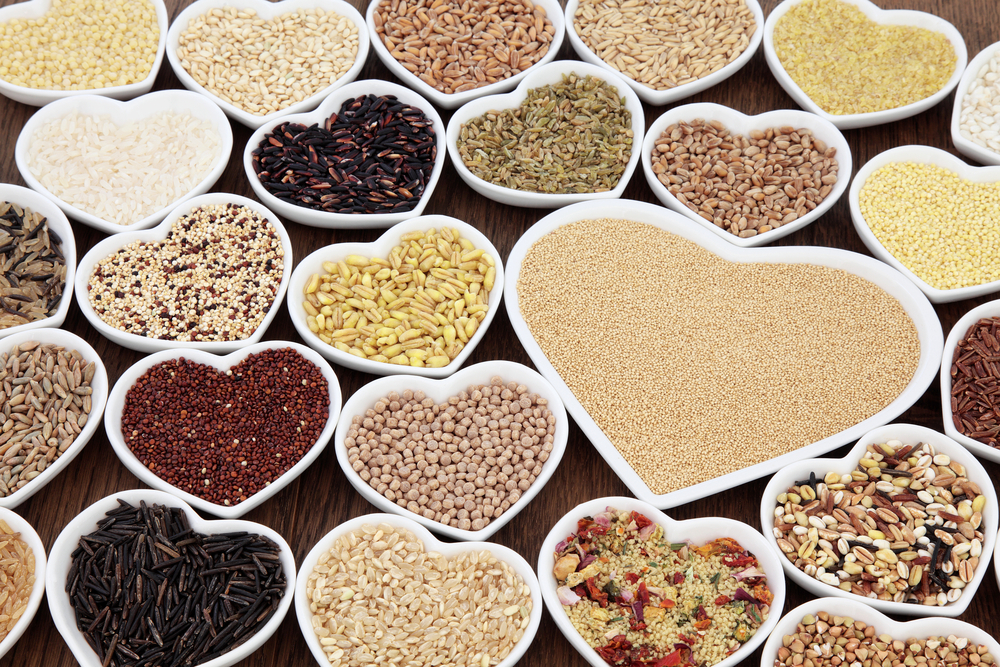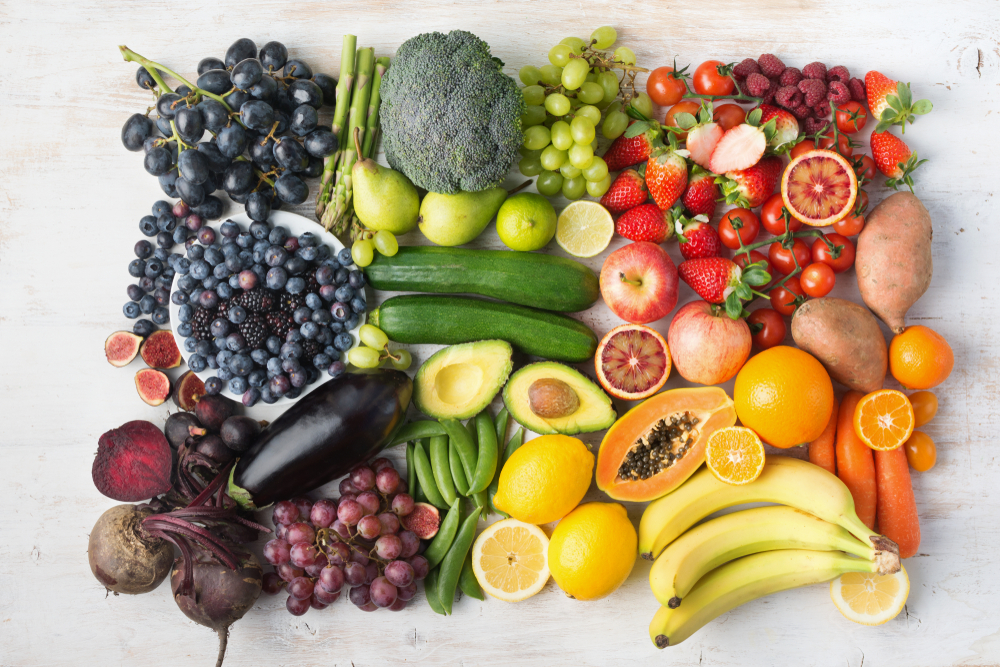
Eating seasonally means eating foods, especially fruits and vegetables, when in season, just as nature intended. Nature is of course extremely clever, and it knows what the body needs at what times of the year.
It also makes sense to eat seasonally from an economic and environmental perspective too.
So, what’s in season right now?
Clinical Nutritionist Suzie Sawyer shares her five favourite fruits and vegetables to enjoy.
Rhubarb

Interestingly, whilst we might think of rhubarb as being a fruit, it’s actually a vegetable! Obviously, that doesn’t change its nutritional offerings which are certainly worth exploring.
As with all fruits and vegetables, rhubarb is packed with immune-boosting vitamin C, also needed for energy production. Vitamin C is also one of our most powerful antioxidants which helps protect the body from free radical damage and in turn, the ageing process.

Rhubarb is a great source of fibre which is essential for keeping the digestive system running smoothly. It’s quite sharp in taste so if it’s going to be used in sweet dishes, it might need a lot of sugar. A rhubarb and apple crumble is great as a treat, but it might be worth thinking of using rhubarb in savoury dishes, perhaps as a tart sauce with duck.
If you’ve not tried rhubarb before then it’s health and taste benefits are well worth exploring.
Kale

A member of the cabbage family, kale is often referred to as a superfood for this reason. This super healthy family of foods contain a compound called sulphoraphane, which is very beneficial for liver detoxification. Research also shows sulphoraphane is very protective against some of our nasty degenerative diseases.
Kale can be slightly tough if not treated kindly during cooking! The younger leaves tend to be more tender and then it can be steamed, boiled, or stir fried and used in a myriad of dishes.

Kale makes a great snack as kale chips, grilled in a little olive oil and sea salt, or made into a soup with any vegetable of choice. Additionally, it’s great in a stir fry or cooked on its own with garlic and toasted pine nuts.
Spinach

Whilst we often think of spinach as being the best source of iron, it’s probably better for its calcium content. Either way, spinach remains a rich source of these key minerals, essential for energy and the bones, and are best absorbed when spinach is cooked.
The good news, therefore, is that spinach is so easy to add to almost anything, as it reduces down massively when cooked. This makes it a great vegetable to add to dishes when you’ve got vegetable ‘avoiders’ in the family! Spinach can even be added to a spaghetti bolognaise and won’t be noticed too much. It’s also great added to soups, stir fries, omelettes or vegetable curries.

Spinach is also a great source of vitamin A and vitamin C which work together as antioxidants, as well as folate, essential for energy and healthy DNA. From a cook’s perspective, it’s very versatile too.
Passion Fruit

Passion fruit doesn’t exactly meet the criteria for being a local fruit but it is in season in the southern hemisphere. Plus, it’s great for the soul to be eating foods that remind us of warmth and sunshine at this time of year. And these summer fruits are also packed with antioxidants which naturally help protect the skin from sun damage, so you’ll be getting all those health benefits too.
Passion fruit is just sweet enough to be eaten on its own, as a delicious snack or dessert treat. However, it can be made into a coulis with other fruits, especially mango (mango chunks are easy from the freezer) or simply pureed and poured over your favourite chocolate cake as a lovely sweet treat!
Asparagus

As we come into April, so we come into English asparagus season. Eating asparagus out of season you may find a lack of taste and often tough texture. So, grab some quick because the season is short!
Asparagus is a nutritional highlight, containing more folate than any other vegetable. Folate is essential for energy production, the nervous system, healthy red blood cell production and DNA repair. Furthermore, asparagus, is packed with glutathione, which is essential for powering our key antioxidant enzyme system.

Even better, asparagus doesn’t need to be complicated in terms of preparation; simply steam and toss in olive oil and salt, roast the same way, or serve as an impressive starter with hollandaise sauce.
Enjoy exploring seasonal fruit and veg this Spring!
FOR MORE GREAT NUTRITION AND LIFESTYLE ADVICE:
Sign up to receive our blog and get a weekly dose of the latest nutrition, health and wellness advice direct to your inbox.
Follow us on Instagram @feelaliveuk for nutrition, lifestyle and well-being tips.
Visit us at www.feelaliveuk.com for the latest offers and exclusive Alive! content.
Follow and Chat with Suzie on Twitter @nutritionsuzie
For everything you need to know about vitamins, minerals and herbs visit our sister site Herbfacts
All images: Shutterstock










 If possible, try to do exercise in the morning. There is another very good reason for this: exercising outside in the bright morning light stimulates the production of melatonin, our sleep hormone, later in the day.
If possible, try to do exercise in the morning. There is another very good reason for this: exercising outside in the bright morning light stimulates the production of melatonin, our sleep hormone, later in the day. However, it’s also important to have foods throughout the day that keep blood sugar levels in balance. When blood sugar is out of whack then it can trigger the release of cortisol. This is our stress hormone, which can create more anxiety, restlessness, and irritability, none of which are conducive to a good night’s sleep!
However, it’s also important to have foods throughout the day that keep blood sugar levels in balance. When blood sugar is out of whack then it can trigger the release of cortisol. This is our stress hormone, which can create more anxiety, restlessness, and irritability, none of which are conducive to a good night’s sleep!  So, think about having an oat-based breakfast, such as overnight oats which is quick and easy to prepare the night before. Go for a salmon or tuna salad for lunch and grilled chicken breast with veggies for dinner. If you’re vegan, soy is also a good source of tryptophan, so a tofu stir fry would be a great option.
So, think about having an oat-based breakfast, such as overnight oats which is quick and easy to prepare the night before. Go for a salmon or tuna salad for lunch and grilled chicken breast with veggies for dinner. If you’re vegan, soy is also a good source of tryptophan, so a tofu stir fry would be a great option. Turn off and don’t look at electronic devices at least two hours before bedtime. Decide what works for you in terms of having a warm bath with some lavender oil, reading a book, meditating or other relaxation techniques. The important point is to stick to a routine and try to keep regular bed and waking times too. And whilst alcohol might seem like a sedative, it is known to disrupt sleep patterns and is often the cause of early morning waking.
Turn off and don’t look at electronic devices at least two hours before bedtime. Decide what works for you in terms of having a warm bath with some lavender oil, reading a book, meditating or other relaxation techniques. The important point is to stick to a routine and try to keep regular bed and waking times too. And whilst alcohol might seem like a sedative, it is known to disrupt sleep patterns and is often the cause of early morning waking. Deep breaths need to start from the belly. You might want to lie down and put your hand on your belly to ensure this is happening until you get used to the feeling. Initially, just try breathing in for four seconds and breathing out to the same intensity for four seconds. In essence, you are regulating your breathing in and out. As you get more practice, then try to do this for 6 seconds each way. The important point here is not to over think it – just concentrate on the breath. After a couple of minutes, you’ll certainly start to feel calmer. Try doing this for five minutes every day before settling down to sleep – you’ll be amazed by the results!
Deep breaths need to start from the belly. You might want to lie down and put your hand on your belly to ensure this is happening until you get used to the feeling. Initially, just try breathing in for four seconds and breathing out to the same intensity for four seconds. In essence, you are regulating your breathing in and out. As you get more practice, then try to do this for 6 seconds each way. The important point here is not to over think it – just concentrate on the breath. After a couple of minutes, you’ll certainly start to feel calmer. Try doing this for five minutes every day before settling down to sleep – you’ll be amazed by the results!






